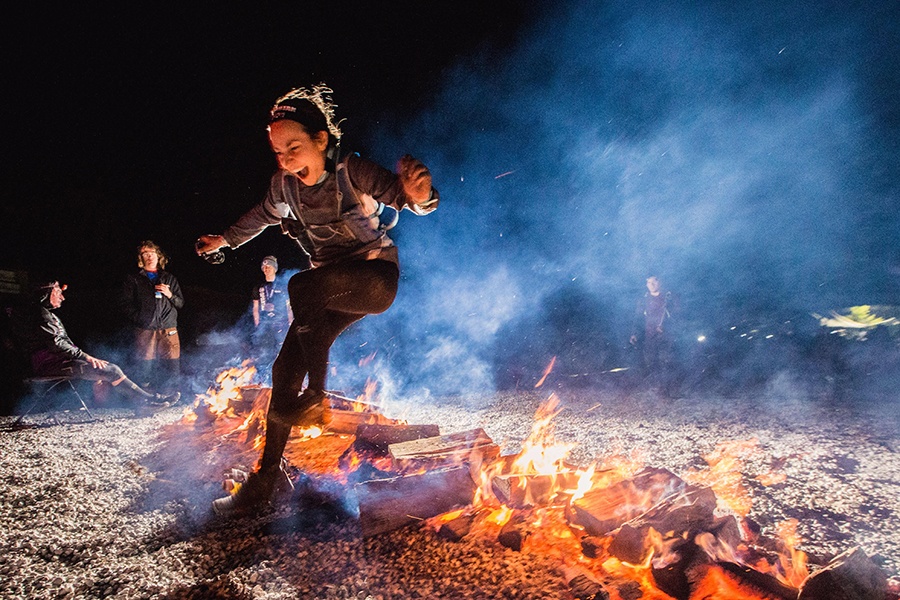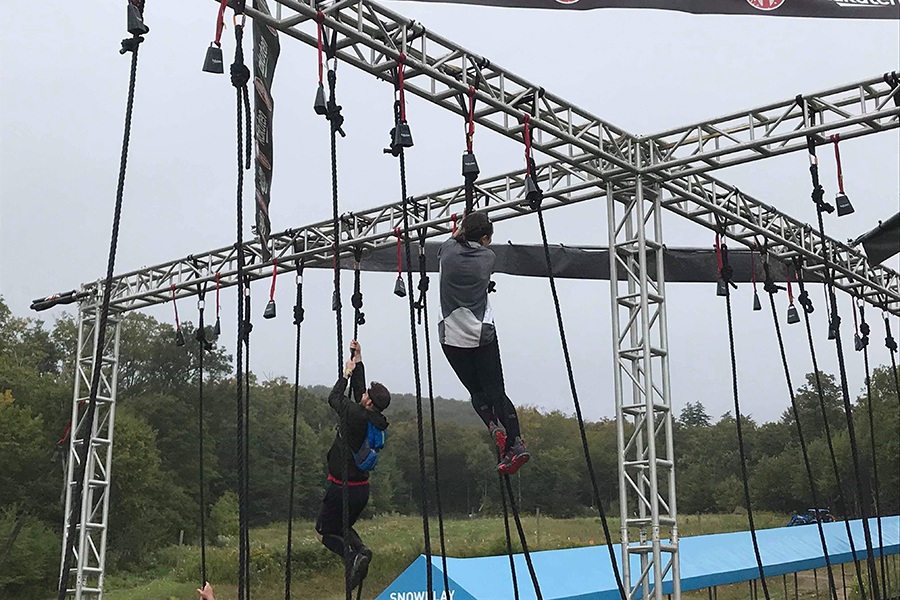13 Tips to Dominate Your First Spartan Race from Start to Finish
Spartan obstacle races—filled with spear throws, crawling under barbed wire, and a ton of burpees—are no joke. Be sure you're prepared.

The face of victory I made after leaping over flames at the finish line of the Spartan Beast Race / Photo courtesy of Spartan
As my numb fingers slipped on the second in a series of swinging ropes I was using to cross a 50 degree lake and I crashed into the depths, I knew I was not prepared for the next 10-plus miles that lay ahead of me. Nevertheless, I flipped over on my back and began swimming toward shore, too stubborn to drop out of the race.
This past September, I competed in Spartan’s Vermont Beast at Killington Mountain. This entails 13.1 miles (or 15.11 miles according to my GPS watch), 30 obstacles, and over 5,000 feet of elevation gain. We hiked through dense forests, slid down ski trails, ran through mud, swam in a lake, and climbed 1.5 miles straight up the mountain at a 25 percent incline. As for those obstacles, we climbed over 10-foot walls, carried 70-pound buckets of rocks, swung from rotating monkey bars, and completed too many burpees to count. At the end of the race, I managed to jump over a fire before crossing the finish line.
Aside from the Beast, the series of races, from the Boston-based Spartan, fall into one of three categories: the Sprint (5k with 20 obstacles), the Super (10k with 25 obstacles), and the Ultra (50k with 60 obstacles). Since starting the beloved but nigh-impossible obstacle races in 2010, founder Joe De Sena has been pushing people around the world (in 42 countries to be exact) to their limits. To succeed, you need to have running endurance, strength, and friends. Unfortunately, I only had two of those—running endurance and friends.
So, to make sure you’re prepared for a Spartan race, here are some tips I wish I knew before hitting the course.
Do your homework
Spartan has created online videos that give you pointers for each obstacle. Be sure to watch the rope climb tutorial. They’ll show you how to wrap the rope around your legs so that you don’t have to use as much upper body strength to hit the bell at the top of the rope.
Hit the gym
Find a gym that offers obstacles similar to the ones you’ll find in a Spartan race. Brooklyn Boulders in Somerville features a “Sunrise Savage” class on Thursday mornings to help you master obstacles such as the spear throw—one of the hardest tasks. And don’t underestimate what a climbing gym can do for you. Grip strength is essential, so gather a group of friends to scale those rock walls.

Photo credit Nick Dalton
Lift heavy
Between the atlas carry, which includes holding a 75-pound ball, and the Hercules hoist (pulling a large weight up with a rope and pulley), you’ll need upper body strength. I realized that I had been lifting for endurance and not strength, so make sure to lift heavier weights. Try deadlifts, farmer’s carries, pushups, and pull-ups.
Cardio, cardio, cardio
Don’t forget to do weekly training runs. Based on the distance of your Spartan race, use free online running schedules such as Hal Higdon’s half marathon program. Incorporate hills or stairs (like stadium bleachers) into your runs, especially if you are competing in a mountain or stadium series race. Don’t forget: The downhill training is just as important as the uphill.
Burpees matter
Incorporate burpees into your runs. If you fail an obstacle, you must stop and complete a pre-determined amount of burpees (depending on which race distance you are running). During easy runs, stop every half mile and complete 30 burpees.
Get over your fear of heights
Or don’t look down when you’re 30 feet up on the A-frame cargo net. Practice climbing up and down a ladder to get comfortable with heights.
Choose clothing wisely
Opt for moisture-wicking fabrics to help you stay cool in hot temperatures. When the forecast predicts rain, or your Spartan race includes water obstacles, choose tight-fitting clothing. Loose clothing will become waterlogged and get heavy. Tight fitting clothing is also less likely to chafe your skin. To combat chafing, use products such as Body Glide and Sports Shield, which can also be used on your toes to prevent blisters. When it comes to socks, choose a pair that reaches your mid-calves or knees, and never wear cotton socks because of their tendency to cause blisters.
Pack hand warmers
When racing in colder temperatures, pack hand warmers to prevent your hands from going numb and interfering with your grip.
Look for ways to make the obstacles easier
There are tips and tricks to make obstacles easier. At the tire flip obstacle, look for divots in the ground so you can get your hands under the tire. When it comes to the bucket brigade (carrying 70 to 100-pounds of rocks), position the bucket on one of your shoulders, or flip the bucket upside down so it’s easier to grip.

Photo credit Nick Dalton
Fuel properly
For longer distances, carry a hydration backpack. There will be water stops, but you’ll be happy to have your own water when hiking through the woods or climbing a mile and a half straight up the mountain. Bite the hydration pack’s straw when swimming under the dunk wall to prevent mud from getting into the mouthpiece. And don’t forget about your sports nutrition, with options such as GU Energy Gels (Salted Caramel and Chocolate Outrageous taste the best), Bloks Energy Chews, and Honey Stinger waffles. Others swear by mustard packets to help with cramping. Pack these in a plastic bag to keep them dry.
Create small goals
It’s easy to get overwhelmed, especially when tackling a Beast. Tell yourself you can take a sip of water when you complete an obstacle, take a break after climbing for five minutes, or eat an energy waffle at mile six. It’s easier to complete the race mentally when you break it up.
Do it with friends
If you are competing in the open category, you can get help from other competitors. My friends boosted me over 10-foot walls (I’m only five feet tall), helped me flip a tire, and carried some of the weighted items. At one point, I found myself standing on their shoulders.
And make friends with other competitors
Be sure to befriend other racers. The Spartan community is welcoming no matter which distance you’re competing in. It’s been said that misery loves company, but it’s also a great feeling to have people cheering you on when you complete an obstacle. And you never know when someone else’s story will inspire you.


